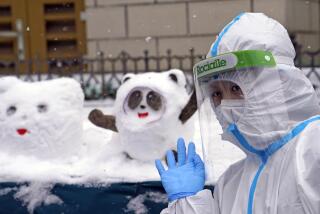Belarus Athlete Tests Positive
- Share via
SALT LAKE CITY — A sample provided by a Belarussian athlete tested positive for the muscle-building steroid nandrolone at 380 times the admissible level, the International Olympic Committee said Monday in announcing that it had excluded a key Belarus official from the Games and cut off funding after the athlete failed to appear for a follow-up test.
The name of the athlete was not immediately disclosed. Sources identified her as a speedskater and said she did not qualify for an Olympic final at the Salt Lake City Games. Her whereabouts late Monday were not known.
A urine sample she provided after being chosen at random for testing showed the elevated nandrolone levels, officials said Monday night. But the result is not technically being considered a positive doping case because of a significant procedural irregularity--the bag in which the sample was being carried was not properly sealed when it arrived at an Olympic testing lab set up here for the Games.
Only five drug cases have been confirmed in Winter Games history, none the past three Games. Urine samples are put through a variety of tests designed to detect narcotics, stimulants, steroids, beta blockers, diuretics and other substances. In all, the IOC bans about 400 substances.
The IOC demanded that the athlete appear Monday for a follow-up test. She did not show.
A “very strange disappearance,” the IOC’s chief operating officer, Francois Carrard, said late Monday, adding that the IOC believes she is still in the United States and perhaps “might not be so far from here.”
IOC President Jacques Rogge “expressly invited” Yaroslav Barichko, Belarus’ team leader, to explain, according to Carrard. He did not show.
In response, the IOC’s policy-making executive board banned Barichko for the duration of the Games and suspended financial support to Belarus’ national Olympic committee for the rest of 2002.
In all, about $120,000 went to Belarus last year. The money was supplied both by the IOC directly and through an IOC support agency called Olympic Solidarity.
Other Belarussian athletes are still permitted to compete at the Games, Carrard said. He said it would be “totally unfair” to penalize the other athletes. Belarus sent 66 athletes to the Games.
*
Apolo Anton Ohno skated Monday for the first time since cutting his left leg in a spectacular short-track crash that probably cost him a gold medal.
Ohno was the last American to take the ice for the one-hour, 15-minute workout, clambering over the boards in a red helmet. He skated slowly at first, staying inside the black lane markers while his teammates zipped around.
Ohno wore a bandage under his skin suit to cover six stitches in his thigh.
“He looked great,” U.S. Coach Susan Ellis said. “He’s in good spirits.”
Ohno was cut by his own skate when four of five skaters collided and fell on the last lap of the 1,000 meters Saturday night. He staggered across the line to claim the silver.
During practice at the Salt Lake Ice Sports Complex, Ohno briefly left the ice to remove the wrap that covered the bandage because it was irritating him.
Ohno’s next race is the 1,500 meters Wednesday.
*
Charles Sinek competed in Monday night’s Olympic free dance despite a lung infection.
Sinek and his wife Beata Handra started off the competition and skated cleanly despite his condition. They finished 23rd out of 24.
Earlier in the day, Sinek had a fever that reached 102 degrees. He became ill Sunday night, but after taking medication, his temperature came down.
“The last 30 seconds of our program, I just couldn’t breathe and my legs didn’t move very well,” he said. “I didn’t feel that good about it.”
*
Times staff writers Alan Abrahamson and Helene Elliott and the Associated Press contributed to this report.
More to Read
Go beyond the scoreboard
Get the latest on L.A.'s teams in the daily Sports Report newsletter.
You may occasionally receive promotional content from the Los Angeles Times.






